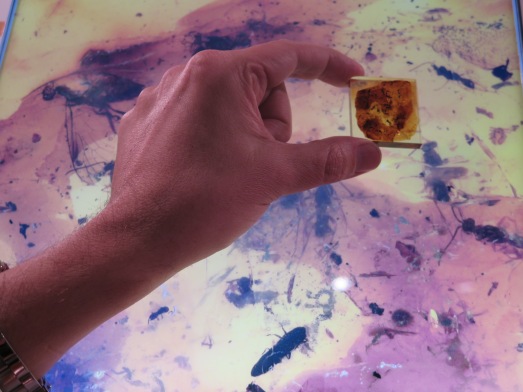 Larvae of ancient beetles also lived in the nests of some theropod dinosaurs and fed on their fallen feathers. Paleontologists came to this conclusion after analyzing several Cretaceous amber fragments from Spain . Their discovery was the first evidence for a commensal-mutualistic relationship between non-avian dinosaurs and arthropods :
Larvae of ancient beetles also lived in the nests of some theropod dinosaurs and fed on their fallen feathers. Paleontologists came to this conclusion after analyzing several Cretaceous amber fragments from Spain . Their discovery was the first evidence for a commensal-mutualistic relationship between non-avian dinosaurs and arthropods :

Some insects and mites feed exclusively on bird feathers. Some of them harm their owners, violating their thermal insulation and ability to fly. However, others are harmless or even helpful, for example by cleaning birds’ nests of old feathers. It is assumed that invertebrates learned to feed on feathers as early as the Mesozoic, and initially these were feathers of non-avian dinosaurs from the theropod group. However, until now, paleontologists have not had direct confirmation of this hypothesis:

They were discovered by a team of specialists led by Enrico Peñalver of the Spanish National Institute of Geology and Mineralogy. The researchers focused on a sample of amber about a hundred million years old (corresponding to the Cretaceous period), which was found in northeastern Spain and was divided into several parts during processing. Inside the fragments, paleontologists discovered numerous fossilized feathers of an unknown theropod species (they could not have belonged to birds, since they had not yet appeared). Together with them, tiny skins of beetle larvae, their feces and small debris discarded during molting were found in amber. Three similar and at the same time perfectly preserved skins were found by the authors in other pieces of Spanish Cretaceous amber, a little older and a little younger than the first:
3
After studying the skins from amber, the researchers concluded that the insects that released them most closely resembled the larvae of modern beetles in the skin beetle family ( Dermestidae ). First of all, this is indicated by the structure of their heads and oral appendages. The larvae of some modern skin beetles feed on feathers and other keratin integuments of vertebrates and often make their home in bird nests. This family already existed in the Cretaceous, as evidenced by numerous findings of larvae and adults, even in amber:
Since all the skins of the larvae of the first amber sample were very close to dinosaur feathers, their owners most likely lived among the feathers. The authors suggest that these insects lived in theropod nests and ate feathers that had fallen from their bodies. Theoretically, it is possible that the skins and feathers fell into the resin independently of each other, after which they were petrified, but both types of inclusions are so rare in amber that the probability of such an occurrence is extremely small. Although the authors could not find significant damage to the feathers encased in amber, less significant insect jaw marks remained on some feather tips.
Peñalver and his co-authors suggest that the beetle larvae they found were eating theropod feathers that had already fallen off. The fact is that traces of decay on the feathers enclosed in amber and the presence of coprolites indicate that these feathers have long been lying on the surface of the earth. Therefore, these insects have not caused harm to the owners. Perhaps they were also useful in that they cleaned nests of old feathers . The study results provided the first evidence for a commensal-mutualistic relationship between arthropods and some non-avian dinosaurs during the Cretaceous. Furthermore, this is another argument in favor of the idea that modern birds inherited many parasites and symbionts from non-avian dinosaurs. For a long time, paleontologists believed that non-avian dinosaurs didn’t have feathers. However, in the last twenty-five years, the opinion has become established among the population that at least many theropods were feathered. The study results were published in an article for the journal Proceedings of the National Academy of Sciences .
#paleontology #dinosaurs #insects









